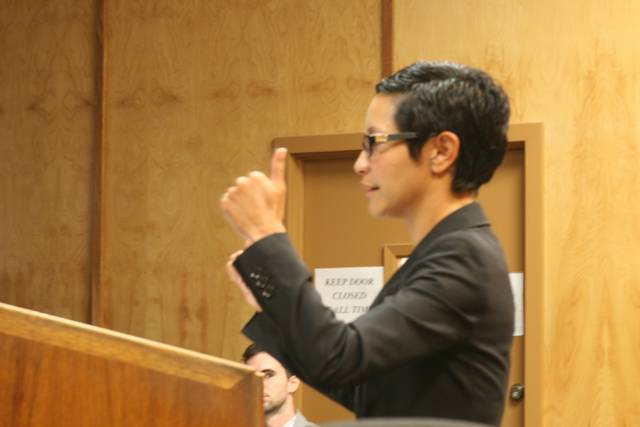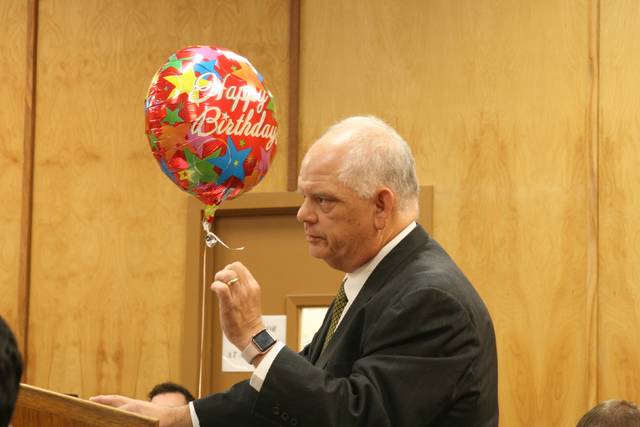KEALAKEKUA — A jury has begun deliberating in the case against former Hawaii County police officer Jody Buddemeyer, accused of negligent homicide after fatally striking a cyclist more than three years ago.
Prosecution and defense presented their closing statements Friday after a two-week jury trial in 3rd Circuit Court.
Deputy Prosecutor Kauanoe Jackson told jurors that Buddemeyer broke his duty as a driver when he failed to preserve life and evidence.
“There were more choices the defendant made to hide evidence and hide his involvement and it started with that first call (to dispatch),” Jackson said.
On March 1, 2015, Buddemeyer was driving his subsidized police vehicle on Waikoloa Road eastbound when he struck Jeffrey Surnow from behind, who was cycling in the same direction. The former officer has also been charged with evidence tampering and false reporting to law enforcement.
Buddemeyer is accused of first-degree negligent homicide. Today, the jury was instructed if they could not reach a unanimous verdict for the first-degree charge they were to consider lesser offenses of second-degree and third-degree negligent homicide.
Throughout the trial, the prosecution presented evidence of broken pieces of Buddemeyer’s vehicle found in the trunk — an act that showed the officer tried to hide evidence at the scene.
“There’s no mistake, that took effort,” Jackson said.
Jackson added Buddemeyer took one more step took to conceal his involvement by parking his vehicle at an angle off the road to hide the damage in the brush.
“That was methodical and that was thoughtful,” she said.
Jackson recalled to the jury’s attention testimony from witnesses the morning of the accident. Those motorists observed a flashing red light on Surnow’s bike. One witness testified he saw Buddemeyer flip the body over then back again.
While Buddemeyer testified he performed chest compressions
on Surnow, no one saw him do so.
“Each of the witnesses corroborate the other without even knowing it,” Jackson stated.
Jackson told the jury Buddemeyer didn’t change his story, but consistently made it more elaborate to test the limits, telling colleagues he hit a pig and asking if he should report the damage to his vehicle.
It was only when his superior officer Lance Ambrose told him something about his story wasn’t right, that Buddemeyer admitted to striking Surnow.
Jackson pointed to decisions made by Buddemeyer prior the crash. The former officer had two days off and called in a sick day prior to working his double-back shift on Feb. 28, 2015.
After working the first shift on Feb. 28, Jackson said, Buddemeyer chose to work two voluntary hours on a speed grant before returning for his next shift seven hours later.
“He decided to work that full shift,” she said. “At 6 a.m., he chose to get into his vehicle from the Mauna Lani substation and continue driving.”
Jackson reminded the jury Buddemeyer called the crash into dispatch as a hit and run, but he remained on scene, controlling what parts of the accident responding officers would see.
Jackson also addressed the experts and doctors presented by the defense, saying the doctors didn’t follow up with officers. The doctors also determined Buddemeyer suffered from acute stress the morning of the accident and possibly a sleep disorder due to lack of sleep with the regular monthly shift change.
Jackson reminded the jury Buddemeyer was never tested for a sleep disorder and doctors didn’t order a study during their examination of the former officer.
“Doctors relied on the self-report of the defendant,” she added.
The experts brought forth by the defense were hardly qualified to speak on the accident or issues surround work scheduling for Hawaii County Police Department, Jackson explained.
The accident reconstruction expert hired by the defense didn’t test Buddemeyer’s vehicle headlights using high beams or with the bicycle’s flashing red light.
Gouge marks in the pavement on Waikoloa Road caused by the bicycle when Surnow was struck indicate how far the cyclist was riding from the fog line. While their expert has said he was 24 inches left of the fog line, Jackson iterated he was still as close as practicable to fog line as the law demands.
“Look at your common sense,” Jackson said. “At this point in time, the state believes you can find the defendant guilty of crimes charged.”
Defense counters
Defense counsel for Buddemeyer, Brian De Lima approached with a balloon that said: “Happy Birthday.” He explained to the jury the balloon represented the state’s “air-tight” case against his client.
However, De Lima told the jurors they could not come back with a guilty verdict if they have the slightest reasonable doubt.
“Reasonable doubt can be as small as the head of a pin,” De Lima said.
At that point, the defense counselor popped the balloon and it slowly deflated to the ground. De Lima added the state’s case is no longer “air-tight.”
“We’re calling upon you to return a verdict,” he told the jury. “It’s not your responsibility to fill the pukas, the holes, in the state’s case.”
With that, De Lima added: “What is the evidence in this case? What are the reasonable doubts?”
The first doubt De Lima raised was Surnow’s bicycle. He explained it wasn’t registered in Hawaii and he brought it from the mainland.
“No witness has come to stand that has said this bike was legally on the street,” De Lima said.
De Lima told jurors the cyclist chose to ride a road that had no shoulder, in the dark, not designed for triathlon riding.
“After the accident, the county did put in 10- to 11-foot paved shoulders,” he said.
De Lima added if a cyclist were riding near the fog line nothing would have happened.
“If you were riding on the fog line nothing definitely would have happened,” he iterated.
De Lima talked about the flashing red light that was affixed to Surnow’s bike. He told the jury the Michigan man had been riding for a couple hours before the accident occurred. It’s unknown how powerful the light was or how quickly it was flashing.
He reminded jurors of the first witness who claimed seeing the flashing red light when he drove past Surnow that morning prior to the crash from between 100 to 150 feet away.
“There’s been no testimony on how long it takes for the light to drain out,” De Lima said.
He recalled for the jury that Buddemeyer said he didn’t see the red light. He didn’t see Surnow.
“He was going the speed limit. He was driving with his headlights,” De Lima said.
The defense counselor moved on to the double-back shift his client had worked the morning of the incident.
“He was working a shift he was ordered to do,” De Lima said. “Not a single department in the state does what Hawaii County does to its sworn personnel.”
Prior to working as an officer on the Big Island, Buddemeyer worked as an officer for the Honolulu Police Department. The former officer testified on Thursday his schedule remained the same for the two years he worked there.
On Friday, De Lima told the jury Buddemeyer inquired and complained about the monthly double-back shift changes.
“It’s just something we’ve always done – we’re never going to change,” De Lima recalled as the responses Buddemeyer was given. “You cannot bank sleep. You cannot bank rest. It don’t work that way.”
Buddemeyer, De Lima added, was a good officer with no disciplinary issues. However, when he saw Surnow’s body for the first time, court-appointed doctors testified he went into a state of acute stress.
Officers on scene all testified Buddemeyer was not acting like himself. The doctors added the former officer was behaving in a dissociative state.
In addition, De Lima reminded the jury the doctors relied on police reports to come up with their conclusions. They had to look at the reports in the case at the probation office. They weren’t allowed to take it home. What was there, was what they had.
No DVDs of police interviews were entered into evidence. No radio transmissions from dispatch were presented to the court.
“The order doesn’t require sleep disorder studies,” De Lima said of the doctors’ review of Buddemeyer. “The order doesn’t require they go out and interview the officers.”
De Lima added a good man has died.
“A family is suffering. There’s no doubt about it,” he said.
De Lima reminded the jury Surnow’s family has a civil case against Buddemeyer and Hawaii County. The case before them was a criminal case that never should have been brought before them.
“Their air-tight case is full of gaping holes,” De Lima said of the prosecution. “What we don’t want is for the jury is to fill the holes.”
The attorney closed by saying it’s been an honor to represent the former officer.
“We ask that you give Jody Buddemeyer … the promise of the years to come,” he said. “We await your verdict and thank you for your attention.”
Jackson gave her closing rebuttal arguments stating there was no reason to move DVDs into evidence when officers were available to provide their live testimonies.
“You have the evidence,” she said. “Photographs for you to make your own independent determination.”
Jackson added the crime happened before a lawsuit could ever happen. Whether the hole he poked in the balloon is convincing, she told the jury it’s inflated by facts presented by the state.
Jackson said Buddemeyer was not in a dissociative state. He had the mind about him that morning on what to collect, what not to collect and when to come clean.
“The defendant would like you to believe it just because a doctor said it,” she said.
The jury was excused at noon to begin its deliberations in the case.









